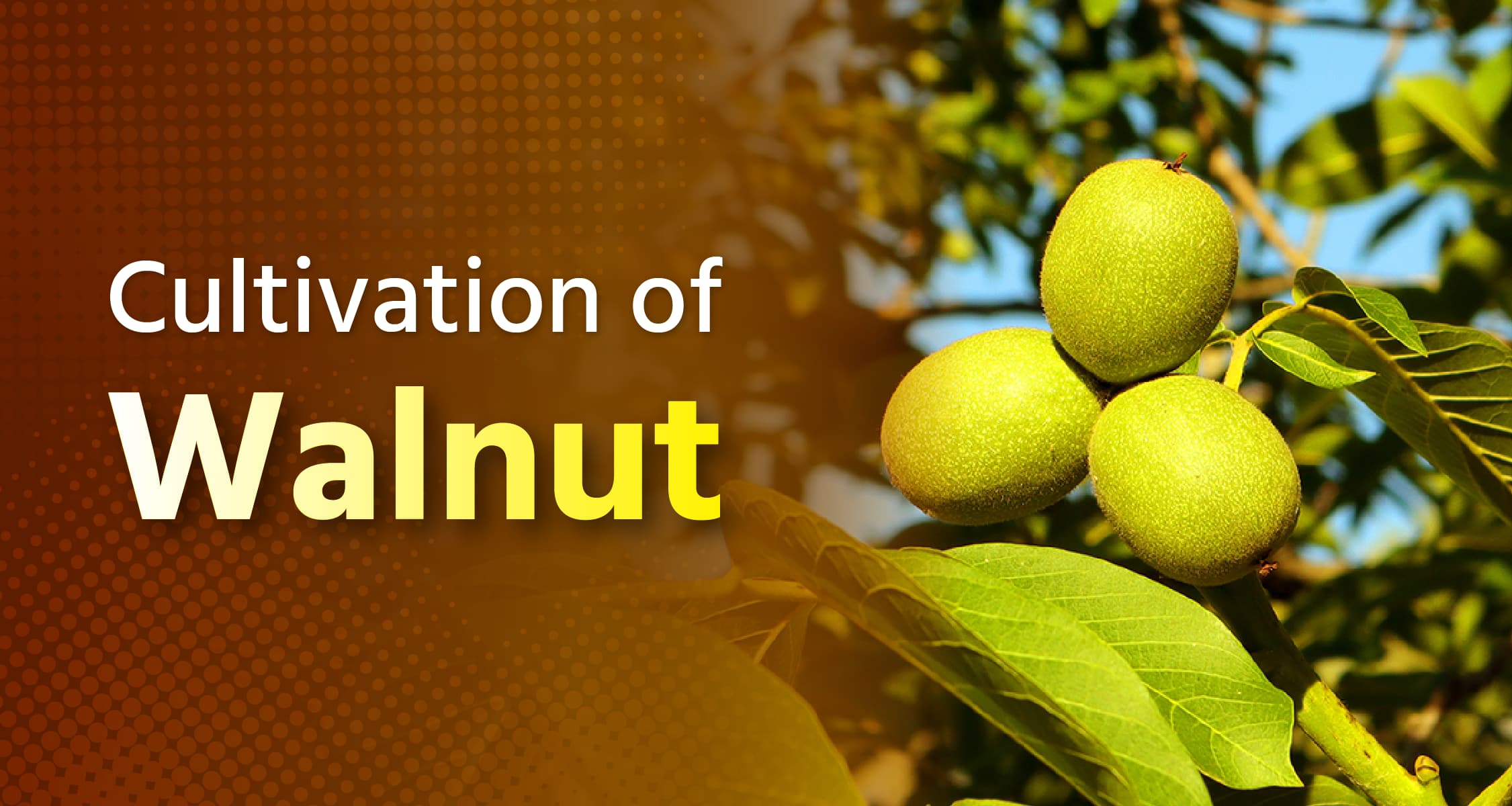Cultivation of Walnut

Walnut cultivation is primarily done in the hilly regions of India, such as Jammu & Kashmir, Himachal Pradesh, Uttarakhand, Uttar Pradesh, and Arunachal Pradesh. In these areas, walnut trees thrive at altitudes ranging from 1200 to 2150 meters above sea level. Jammu & Kashmir is the leading state in walnut production.
Walnuts contain 14.8 grams of protein, 64 grams of fat, 15.80 grams of carbohydrates, 99 milligrams of calcium, 380 milligrams of phosphorus, and 450 milligrams of potassium per 100 grams. Additionally, 50 grams of walnuts provide 392 calories of energy, 9 grams of protein, 39 grams of fat, and 8 grams of carbohydrates, and are rich in vitamin E, B6, and minerals.
How to Cultivate Walnut?
Soil
- The most suitable soil for walnut cultivation is well-drained loamy soil. The soil pH should be between 6 and 7. Sandy and hard soils are not suitable. The soil should not be barren or alkaline.
Climate
- Walnut cultivation is best suited for climates that are neither too hot nor too cold. Excessive heat can damage the fruits and plants, while extreme cold and frost can hinder plant growth. An optimal temperature range for walnut cultivation is 20 to 25°C. Cooler climates are better during the fruit-growing period.
Sowing Time
- The most suitable time for walnut cultivation is from December to March. In some regions, walnuts are also cultivated during the rainy season, but planting in December allows the plants to benefit from favorable weather for a longer period, enhancing their growth.
Varieties
- In India, some of the major improved varieties of walnuts include Pusa Khor, Placentia, Wilson, Franquette, Pratap, Gobind, Eureka, Sultani Selection, etc.
Field Preparation
- Walnut plants are planted in pits. First, plow the field deeply using a tractor, moldboard plow, or cultivator, and leave it open for a few days. Then, use a rotavator to make the soil friable, and level the land with a harrow. Prepare pits that are two feet wide and one to one and a half feet deep, maintaining a distance of no more than five meters between pits and rows.
Nursery Preparation
- Walnut seedlings are prepared about a year before planting, in May and June. In the nursery, plants are prepared using the grafting method, ensuring that all the qualities of the main plant are retained in the new plants. Seed-grown plants start bearing fruit after 20 to 25 years, while grafted plants begin to produce within a few years and are of better quality. The pit size for the main plant should be 1.25 x 1.25 x 1.25 meters, and the distance between plants should be 10x10 meters. The best time for planting is in September. In the nursery, maintain a row-to-row distance of 50 cm and a seed-to-seed distance of 25 cm. By preparing a proper nursery and using the grafting method, successful walnut cultivation can be achieved.
Fertilizers and Manure
- Before planting walnut trees, each pit should be filled with 10 to 12 kg of cow dung manure and 100 to 150 grams of chemical fertilizer, thoroughly mixed with the soil. If the soil in the field lacks zinc, add a small amount of zinc as well. Use well-rotted cow dung manure or vermicompost to enhance plant growth. Apply 50 kg of farmyard manure (FYM), 150 grams of urea, 500 grams of SSP, and 500 grams of MOP fertilizer.
Irrigation
- Walnuts require irrigation according to the season. During the cold season, water the plants every 20 to 30 days, and in case of severe frost, give a light watering. Immediately irrigate after planting and water once a week during early summer. Fully grown trees need irrigation 7 to 8 times a year.
Weed Control
- To prevent weeds in the walnut orchard, periodically weed around the plants as needed.
Intercropping
- Walnut plants start yielding about four years after planting. During this period, farmers can easily grow short-duration horticultural crops (like papaya), vegetables, medicinal, and spice crops in the empty spaces between the trees, ensuring continuous production from their fields.
Harvesting
- Walnut plants start bearing fruit about 6 to 10 years after planting. Harvest when the outer shell of the fruits starts to crack. When the fruits begin to fall on their own, and about 20% of the fruits have fallen, use a long bamboo stick to knock down the remaining fruits. Gather the fallen fruits and cover them with the tree’s leaves.
Storage
- Proper organization and storage of walnuts are crucial to prevent damage from pests and fungi. To keep walnuts safe for a long time, the temperature should be between -3°C to 0°C. Additionally, low humidity in storage is necessary to maintain the freshness and quality of the walnuts.
Have you ever cultivated walnuts? Share your thoughts and experiences in the comments. For more informative and interesting content, follow the 'Horticulture' channel now. If you found this post informative, please give it a like, and don’t forget to share it with your farmer friends.
Frequently Asked Questions (FAQs)
Q: When should walnuts be planted?
A: Walnut trees can be planted any time from November to April, as the trees are dormant during this period. December to March is considered the best time for planting, as it provides the plants with favorable weather for better growth. It is important to protect the plants from frost.
Q: How many years does it take for a walnut tree to bear fruit?
A: Walnut trees typically start bearing fruit after 20 to 25 years. However, the Pusa walnut variety, which is a paper-shelled type, starts producing fruit in three to four years. Newer varieties of walnut trees also begin to fruit in three to four years.
Q: What is the best variety of walnuts?
A: Walnut trees are primarily found in the Indian states of Jammu & Kashmir, Uttarakhand, and Himachal Pradesh. Walnut cultivation is successful in these regions due to their suitable cold climate. Walnut farming is less effective in flat areas. The ideal temperature for walnut cultivation is between 20 to 25°C, which supports healthy tree growth and good production.
Q: In which states are walnut trees found?
A: Walnut trees are mainly found in the Indian states of Jammu & Kashmir, Uttarakhand, and Himachal Pradesh. The cold climate in these regions is ideal for successful walnut cultivation. Walnut farming is less effective in flat areas. The optimal temperature for walnut trees is between 20 to 25°C, which is suitable for their healthy growth and good yield.
Q: How should one choose land for walnut cultivation?
A: When selecting land for walnut cultivation, it is important to consider a few key factors. Well-drained loamy soil with adequate organic matter is the most suitable. This type of soil provides the necessary nutrients and water for the healthy growth and good production of walnut plants. In contrast, sandy and hard surface soils are not suitable for walnut cultivation as they do not allow for good water drainage and can hinder plant growth.
Please login to continue

Get free advice from a crop doctor
